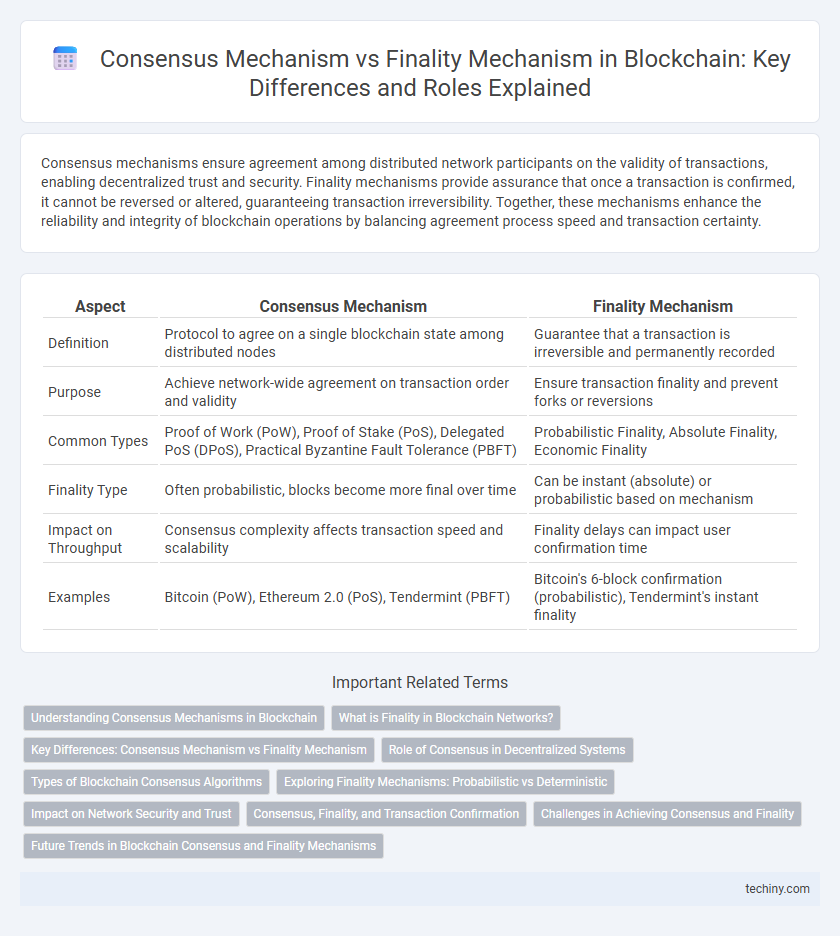Consensus mechanisms ensure agreement among distributed network participants on the validity of transactions, enabling decentralized trust and security. Finality mechanisms provide assurance that once a transaction is confirmed, it cannot be reversed or altered, guaranteeing transaction irreversibility. Together, these mechanisms enhance the reliability and integrity of blockchain operations by balancing agreement process speed and transaction certainty.
Table of Comparison
| Aspect | Consensus Mechanism | Finality Mechanism |
|---|---|---|
| Definition | Protocol to agree on a single blockchain state among distributed nodes | Guarantee that a transaction is irreversible and permanently recorded |
| Purpose | Achieve network-wide agreement on transaction order and validity | Ensure transaction finality and prevent forks or reversions |
| Common Types | Proof of Work (PoW), Proof of Stake (PoS), Delegated PoS (DPoS), Practical Byzantine Fault Tolerance (PBFT) | Probabilistic Finality, Absolute Finality, Economic Finality |
| Finality Type | Often probabilistic, blocks become more final over time | Can be instant (absolute) or probabilistic based on mechanism |
| Impact on Throughput | Consensus complexity affects transaction speed and scalability | Finality delays can impact user confirmation time |
| Examples | Bitcoin (PoW), Ethereum 2.0 (PoS), Tendermint (PBFT) | Bitcoin's 6-block confirmation (probabilistic), Tendermint's instant finality |
Understanding Consensus Mechanisms in Blockchain
Consensus mechanisms in blockchain ensure network agreement by validating and recording transactions across distributed nodes, enhancing security and trustlessness. Finality mechanisms, on the other hand, guarantee the irreversibility of a confirmed block, preventing chain reorganizations and double-spending attacks. Understanding the interplay between consensus and finality is critical for evaluating blockchain performance, scalability, and transaction confirmation speed.
What is Finality in Blockchain Networks?
Finality in blockchain networks ensures that once a transaction is confirmed, it becomes irreversible and permanently recorded on the ledger. This guarantees security and trust by preventing double-spending and transaction reordering. Finality mechanisms vary across consensus protocols, such as probabilistic finality in Proof of Work and deterministic finality in Byzantine Fault Tolerant algorithms.
Key Differences: Consensus Mechanism vs Finality Mechanism
Consensus mechanisms in blockchain networks enable distributed nodes to agree on the validity of transactions, ensuring a unified ledger state despite potential faults or malicious actors. Finality mechanisms guarantee when a transaction is irreversibly committed to the chain, preventing forks or reversion, which is critical for transaction certainty. While consensus provides a method for nodes to propose and validate blocks, finality confirms the permanence of those blocks, distinguishing probabilistic finality in Proof-of-Work from absolute finality in Byzantine Fault Tolerance protocols.
Role of Consensus in Decentralized Systems
Consensus mechanisms enable decentralized systems to achieve agreement on a single data value or blockchain state across distributed nodes, ensuring data consistency and trustlessness. They facilitate transaction validation, prevent double-spending, and maintain network security by requiring nodes to follow protocol rules before adding new blocks. Finality mechanisms complement consensus by guaranteeing when a transaction or block becomes irreversible and permanently recorded on the blockchain.
Types of Blockchain Consensus Algorithms
Proof of Work (PoW), Proof of Stake (PoS), and Delegated Proof of Stake (DPoS) are prominent types of blockchain consensus algorithms that validate transactions and secure the network. Each algorithm employs distinct mechanisms to achieve consensus, with PoW relying on computational puzzles, PoS using economic stake for validator selection, and DPoS leveraging elected delegates for transaction confirmation. Finality mechanisms, such as probabilistic finality in PoW and absolute finality in Byzantine Fault Tolerant (BFT) algorithms, determine the irreversibility of confirmed blocks, ensuring consistency and trust in blockchain transactions.
Exploring Finality Mechanisms: Probabilistic vs Deterministic
Finality mechanisms in blockchain determine when a transaction is irrevocably confirmed, with probabilistic finality relying on increasing confidence over time, as seen in Proof of Work systems like Bitcoin. Deterministic finality guarantees immediate and absolute transaction confirmation, typical in Byzantine Fault Tolerant consensus protocols such as Tendermint or Practical Byzantine Fault Tolerance (PBFT). Understanding these mechanisms is crucial for optimizing network security, transaction speed, and scalability in decentralized ledger technologies.
Impact on Network Security and Trust
Consensus mechanisms like Proof of Work (PoW) and Proof of Stake (PoS) establish agreement on the blockchain state by validating transactions through decentralized participation, directly impacting network security by preventing double-spending and malicious attacks. Finality mechanisms ensure that once a block is confirmed, it becomes immutable, boosting trust by providing certainty that transactions cannot be reverted or altered. The interplay between consensus and finality mechanisms strengthens overall blockchain robustness, reducing vulnerabilities and enhancing user confidence in decentralized networks.
Consensus, Finality, and Transaction Confirmation
Consensus mechanisms ensure agreement among distributed network nodes on the validity of transactions, enabling secure and trustless operation of blockchain systems. Finality mechanisms guarantee the irreversible confirmation of transactions, preventing forks and double-spending by establishing a point after which a transaction cannot be altered or reverted. Effective transaction confirmation depends on both consensus and finality protocols working together to maintain the integrity and consistency of the blockchain ledger.
Challenges in Achieving Consensus and Finality
Consensus mechanisms in blockchain face challenges such as network latency, Byzantine faults, and scalability issues that complicate agreement among distributed nodes. Finality mechanisms struggle with ensuring irreversible transaction confirmation amid potential forks and adversarial attacks, which can delay or undermine transaction finality. Balancing security, speed, and decentralization remains critical in addressing these challenges to maintain robust and reliable blockchain networks.
Future Trends in Blockchain Consensus and Finality Mechanisms
Future trends in blockchain consensus mechanisms emphasize scalability and energy efficiency, integrating Proof of Stake (PoS) and novel hybrid models to enhance transaction throughput. Finality mechanisms are evolving towards probabilistic and deterministic approaches, ensuring quicker, irreversible transaction confirmations critical for enterprise and cross-chain interoperability. Innovations like sharded consensus and zero-knowledge proofs will drive advancements in both consensus reliability and finality speed, shaping the next generation of blockchain networks.
Consensus mechanism vs Finality mechanism Infographic

 techiny.com
techiny.com